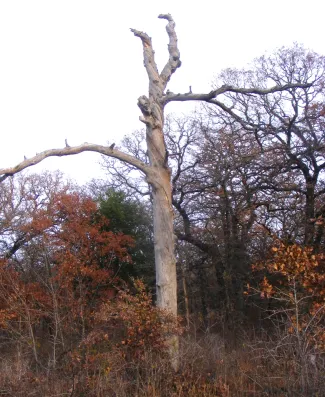Few trees add more character to a woodland or forest habitat than those that are dead or dying. For wildlife, snags are pillars of life that are eagerly sought after, and those easily managed for too.

Standing dead trees add character and diversity to any habitat type and help meet the day-to-day needs of many birds, mammals, and insects.
Dead standing trees, or snags, are best defined as wildlife trees. From the time a standing tree dies until it disintegrates from the forest floor, its many stages of decomposition attract a large variety of birds, mammals, reptiles, and amphibians. In all, more than seven dozen species of North American birds use these trees for nesting, shelter, feeding, and perching. Beetles, spiders, ants, mites, millipedes, and a host of other insects are easily found using dead trees, and these insects further diversify the value of snags as wildlife “hot-spots.”
Unfortunately, dead standing trees can be in short supply within any wooded habitat type. Whether a forest setting, oak savanna, urban landscape, or an isolated tree overlooking a field, snags add great value and should be included when making management decisions. The questions are, how many should there be and does size matter.
Overall, the number and size of available snags will affect not only the presence or absence of snag-dependent wildlife, but also their population levels. Having two to four standing dead trees in a variety of sizes and well-distributed throughout an acre of forest will help meet the needs and requirements of multiple species, including territorial species like woodpeckers. In addition, snags with differing levels of decomposition will also add to the diversity. In general, snags between 12 and 15 inches in diameter at breast height are ideal.
The next question is what can land managers do if natural snags are absent or too few where wildlife diversity is a goal. The first solution is to discontinue the removal of select dead or dying trees. All too often, dead and dying trees are cut down for firewood. Simply allowing a few of the largest or best-suited trees to remain standing is a good goal to shoot for each year, especially those that do not pose a safety hazard. Keep in mind, these snags can be vulnerable to fire, so raking the leaves away from snags or reducing the fuel load around them can be important to retain their value longer.
Another option when snags are in short supply is to kill select trees through girdling or hack and squirting. Doing this every few years will vary the level of decomposition and add greater diversity to the community by assuring the presence of snags year after year. In some cases, setting aside small patches of forest to age naturally will create standing dead trees over time as trees come and go through natural processes.
Another question that may arise is whether nest boxes can be used as an equal alternative to tree snags. Certainly, nest boxes can have great value and are readily used by many nesting birds and mammals; however, tree snags have food and cover values that nest boxes simply can’t match. Still, managing for a mix of standing dead trees and deciding to add nest boxes to the landscape can further diversify the habitat for wildlife, especially within urban habitats and smaller acreages for which nest boxes are often more popular, if not practicable. Remember, the size of the entrance hole and internal cavity are important, so diversifying the nest box type and design is important when maximizing diversity is the goal.
Truly, dead standing trees can and will benefit a host of game and nongame species alike whether occurring in upland habitats or along a stream or creek. Combining snags with other habitat-enhancing measures will further boost the diversity and production of Oklahoma’s wildlife.